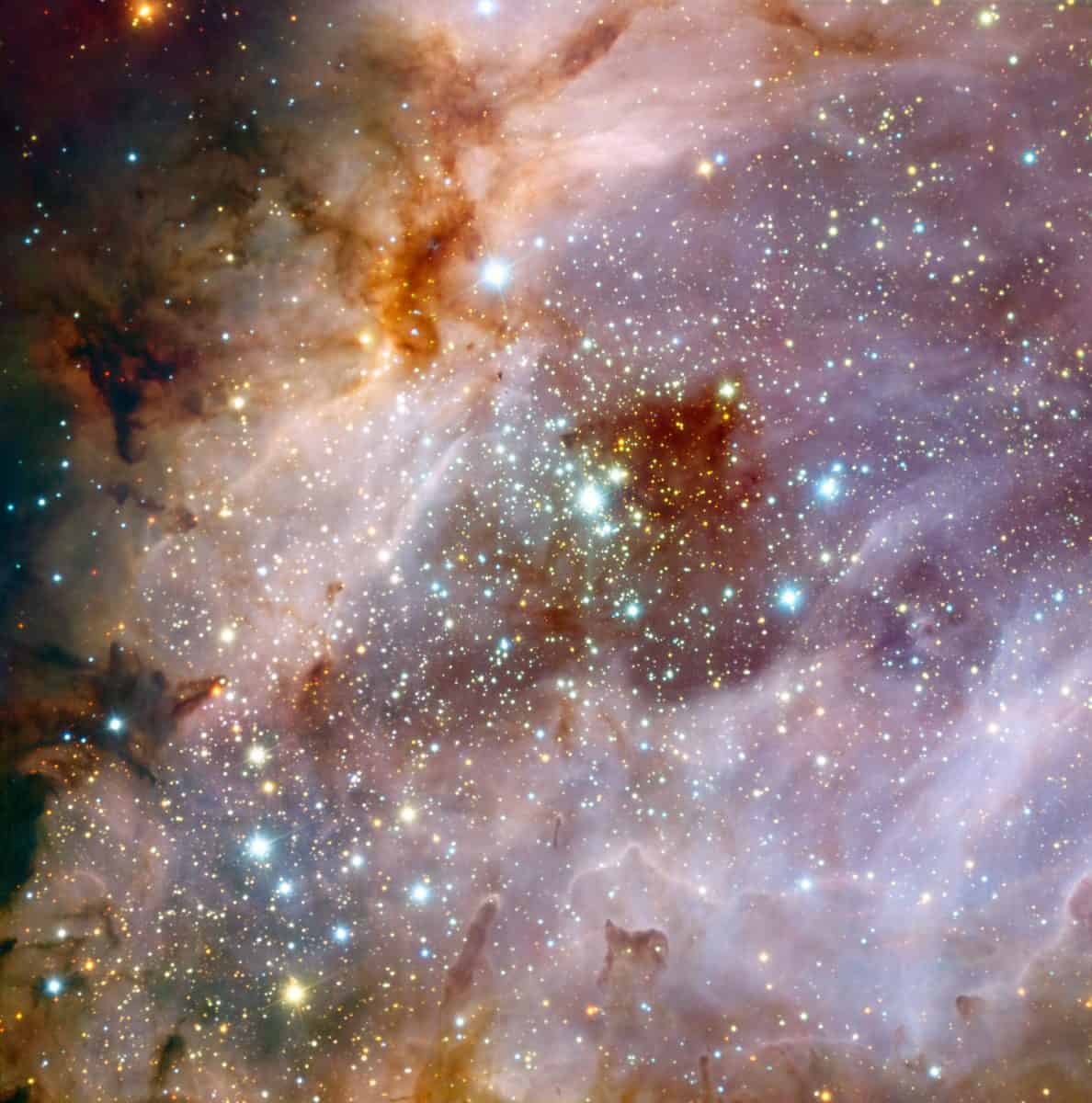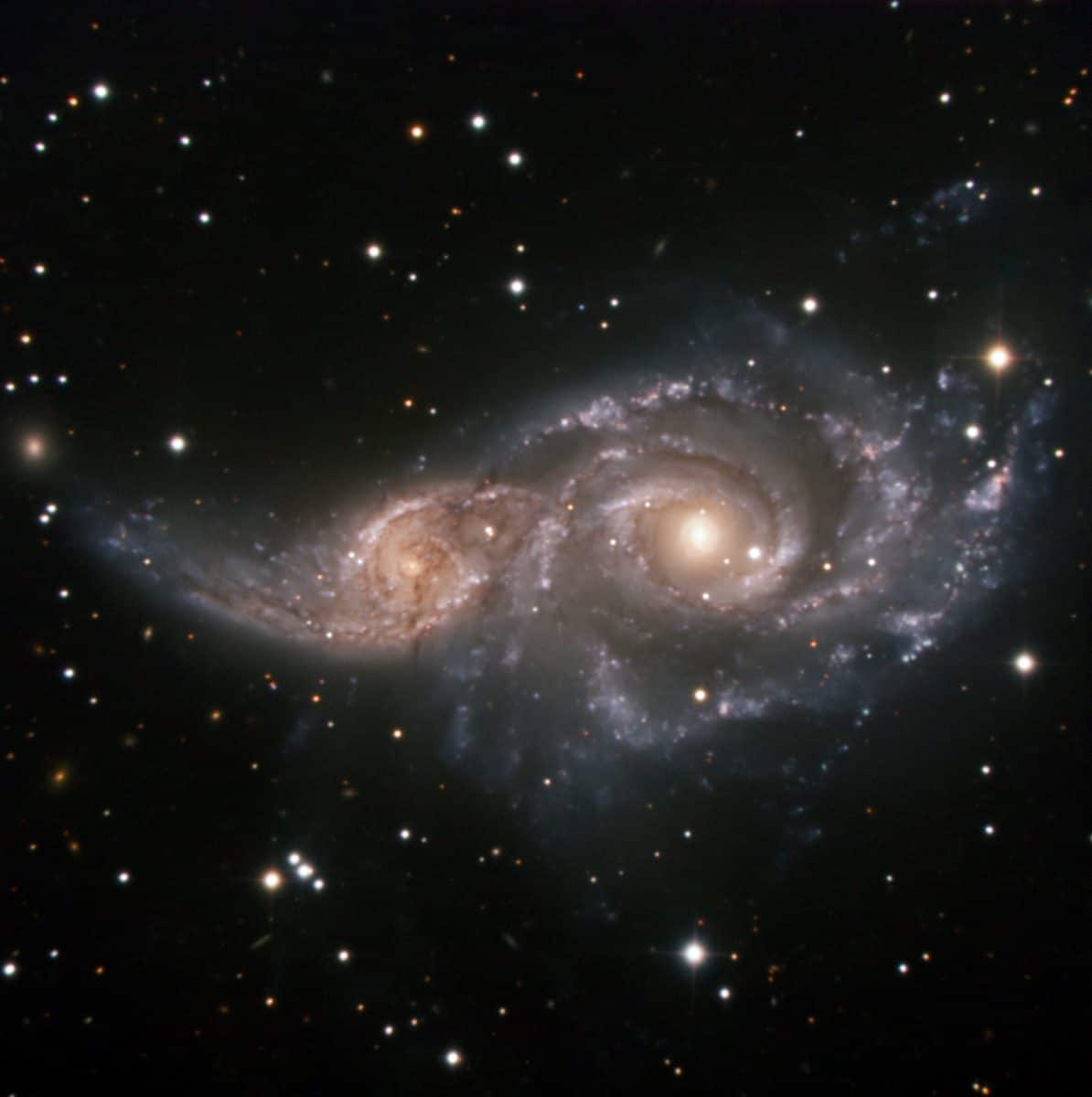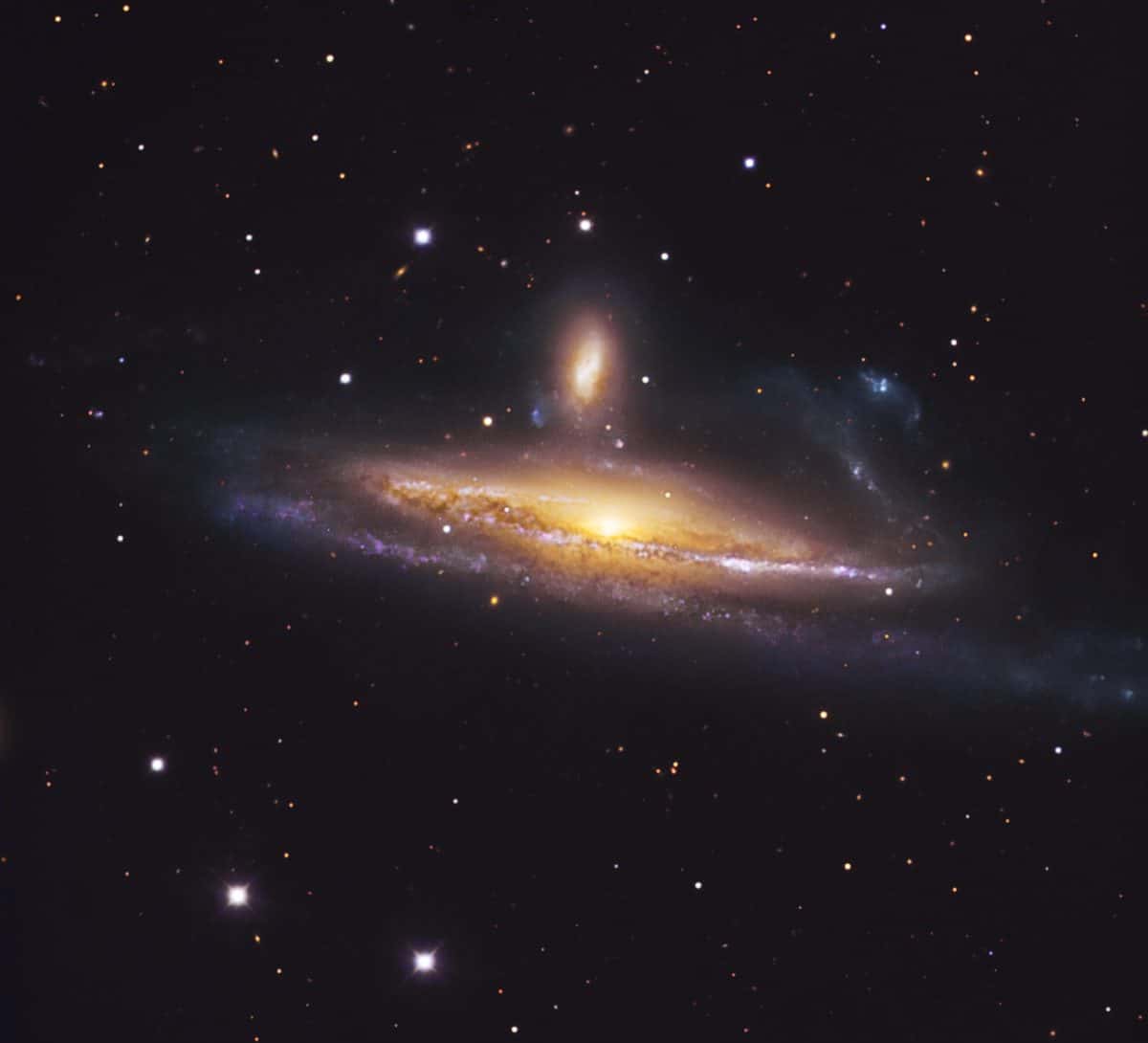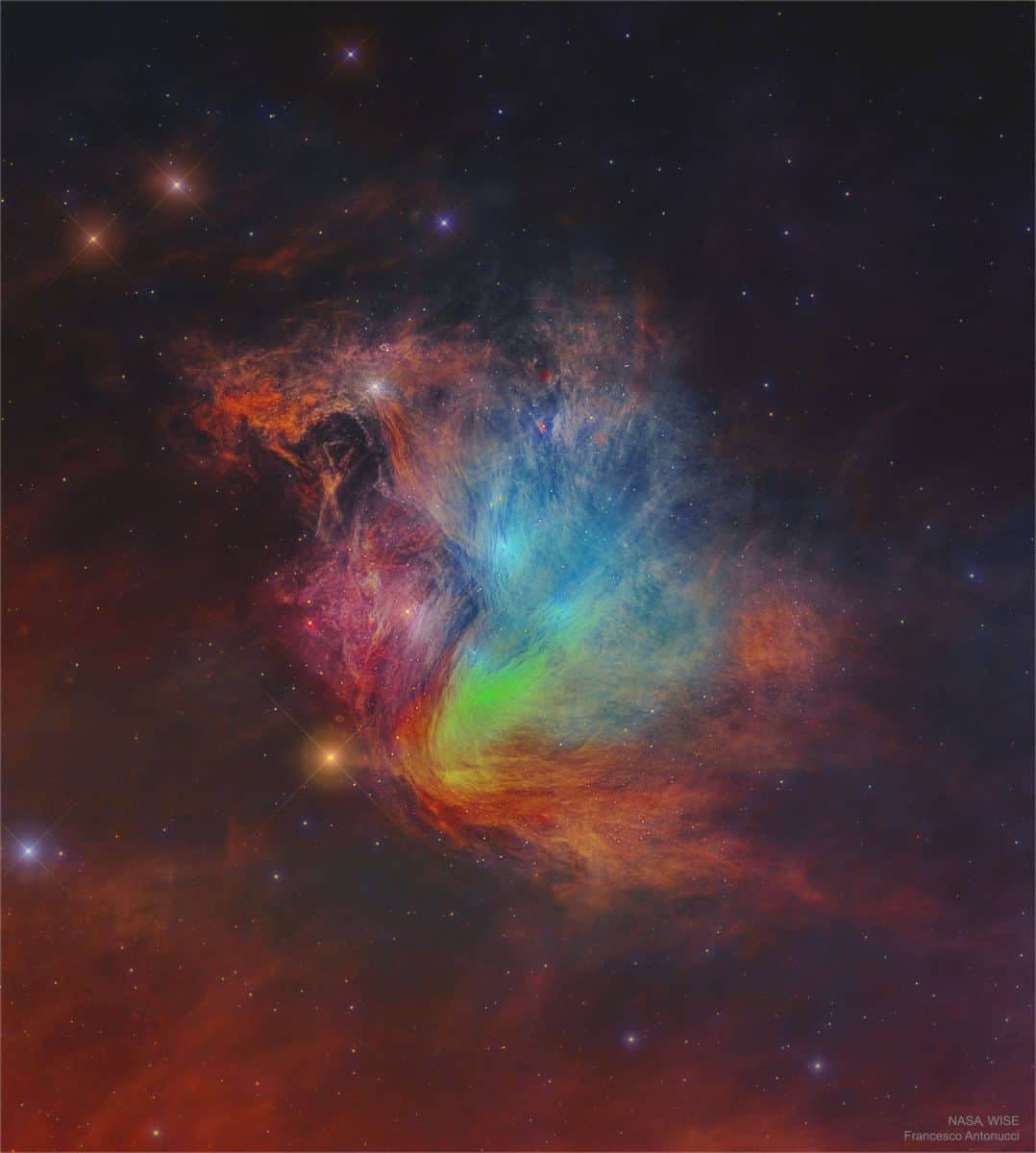Blog
In this image, two spiral galaxies, similar in looks to the Milky Way, are participating in a cosmic ballet, which, in a few billion years, will end up in a complete galactic merger — the two galaxies will become a single, bigger one.
Located about 150 million light-years away in the constellation of Canis Major (the Great Dog), NGC 2207 — the larger of the two — and its companion, IC 2163, form a magnificent pair. English astronomer John Herschel discovered them in 1835.
The fatal gravitational attraction of NGC 2207 is already wreaking havoc throughout its smaller partner, distorting IC 2163’s shape and flinging out stars and gas into long streamers that extend over 100,000 light-years. The space between the individual stars in a galaxy is so vast, however, that when these galaxies collide, virtually none of the stars in them will actually physically smash into each other.
This image was captured with the ESO Faint Object Spectrograph and Camera (EFOSC2) through three wide band filters (B, V, R). EFOSC2 has a 4.1 x 4.1 arcminute field of view and is attached to the 3.6-metre telescope at ESO’s La Silla Observatory in Chile.
more...born May 30th 1962
Darrell Grant, performer, composer and Portland State University professor, has built an international reputation as a stellar pianist and versatile musician. A gifted artist whose four previous recordings have topped jazz charts, Darrell explores the lyricism and soul of songs with beauty, joy and passion. He has appeared on major concert stages from the Weill Recital Hall at Carnegie Hall to the Monterey, Telluride and San Francisco Jazz Festivals. He has been a guest on Marian McPartland’s “Piano Jazz” on NPR and toured internationally with many jazz legends.
Born in 1962 in Philadelphia, Grant moved to Denver, CO, as a young child. Starting piano lessons before his teens, Grant was enough of a prodigy that he joined the Boulder, CO-based Pearl Street Jazz Band, a young but internationally renowned traditional New Orleans-style combo, at the age of 15, touring worldwide with the group for two years. Grant won a scholarship to the Eastman School of Music in Rochester, NY, at the age of 17; while at Eastman, Grant focused on performance studies over theory, which he covered in his graduate studies in jazz theory and composition at the University of Miami.
more...Dave McKenna (May 30, 1930 – 18 October 18, 2008) was an American jazz pianist known primarily as a solo pianist and for his “three-handed” swing style. He was a significant figure in the evolution of jazz piano.
At age 15, McKenna worked in big bands with Charlie Ventura (1949) and Woody Herman’s Orchestra (1950–’51). He then spent two years in the military before returning to Ventura (1953–’54). During his career he worked in swing and dixieland settings with Al Cohn, Eddie Condon Stan Getz, Gene Krupa, Zoot Sims, Joe Venuti[1], and often with Bob Wilber and Bobby Hackett. McKenna released his first solo album in 1955. During the 1980s, he worked as a pianist at the Copley Plaza Hotel in Boston.
more...Benjamin David “Benny” Goodman (May 30, 1909 – June 13, 1986) was an American jazz clarinetist and bandleader known as the “King of Swing”.
In the mid-1930s, Goodman led one of the most popular musical groups in the United States. His concert at Carnegie Hall in New York City on January 16, 1938 is described by critic Bruce Eder as “the single most important jazz or popular music concert in history: jazz’s ‘coming out’ party to the world of ‘respectable’ music.”
Goodman’s bands launched the careers of many major jazz artists. During an era of racial segregation, he led one of the first well-known integrated jazz groups. Goodman performed nearly to the end of his life while exploring an interest in classical music.
The Maxwell street ghetto where Goodman grew up
Goodman was born in Chicago, the ninth of twelve children of poor Jewish emigrants from the Russian Empire. His father, David Goodman (1873–1926), came to America in 1892 from Warsaw in partitioned Poland, and became a tailor. His mother, Dora (née Grisinsky, 1873–1964), came from Kovno, partitioned Poland. His parents met in Baltimore, Maryland, and moved to Chicago before Benny was born. With little income and a large family, they moved to the low-rent Maxwell Street neighborhood, an overcrowded slum near the railroad yards and surrounding factories, populated mostly by Irish, German, Scandinavian, Italian, Polish, and Jewish immigrants.
more...Gjallarhorn rejuvenated traditional music rooted in the Swedish folk music of Finland. Their music was a modern echo of the ancient Nordic folk tradition with mythical medieval ballads, whirling minuets, prayers in runo-metric chanting and ancient Icelandic rÍmur (sung poetry) epics.
https://www.youtube.com/watch?v=3cnON5E8NuU
more...The pair of galaxies NGC 1531/2, engaged in a spirited waltz, is located about 70 million light-years away towards the southern constellation Eridanus (The River). The deformed foreground spiral galaxy laced with dust lanes NGC 1532 is so close to its companion — the background galaxy with a bright core just above the centre of NGC 1532 — that it gets distorted: one of its spiral arms is warped and plumes of dust and gas are visible above its disc. The cosmic dance leads to another dramatic effect: a whole new generation of massive stars were born in NGC 1532 because of the interaction. They are visible as the purple objects in the spiral arms.
This exquisite image was made using the 1.5-metre Danish telescope at the ESO La Silla Observatory, Chile. It is based on data obtained through three different filters: B, V and R. The field of view is 12 x 12 arcmin.
more...Wycliffe A. Gordon (born May 29, 1967) is an American jazz trombonist, arranger, composer, band leader, and music educator at the collegiate-conservatory level. Gordon also sings and plays didgeridoo, trumpet, tuba, and piano. His nickname is “Pinecone”.
Gordon was born in Waynesboro, Georgia into a religious and musical background that influenced the early direction of his music. His father, Lucius Gordon (1936–1997), was a church organist at several churches in Burke County, Georgia and a classical pianist and teacher. Gordon took an interest in jazz in 1980 when he was thirteen, while listening to jazz records inherited from his great-aunt. The collection included a five-LP anthology produced by Sony-Columbia. In particular, he was drawn to musicians like Louis Armstrong and the Hot Fives and Hot Sevens.
more...born 5-29-1952
Wayne Wallace is professor of practice in jazz studies and jazz trombone at the Indiana University Jacobs School of Music.
A seven-time Grammy nominee, he is one of the most respected exponents of African American-Latin music in the world today.
Wallace is known for the use of traditional forms and styles in combination with contemporary music and has earned wide critical acclaim, including placement in both the trombone and producer categories of the DownBeat Critics Poll.
He is an accomplished arranger, educator, and composer with compositions for film and television. He has received grants from the Creative Work Fund, the National Endowment for the Arts, the Lila Wallace Foundation, and the San Francisco Arts Commission.
Wallace has performed, recorded, and studied with many acknowledged masters of the Afro-Latin and jazz idioms, such as Aretha Franklin, Bobby Hutcherson, Earth Wind and Fire, Pete Escovedo, Santana, Julian Priester, Conjunto Libre, Whitney Houston, Tito Puente, Steve Turre, John Lee Hooker, Con Funk Shun, Francisco Aguabella, Manny Oquendo and Libre, Max Roach, the Count Basie Orchestra, and Orestes Vilató. This experience has provided a solid foundation for Wallace’s current explorations of the intersections of a wealth of cultural styles and rhythmic concepts.
Born and raised in San Francisco, Calif., Wallace was exposed to blues, country and western, R&B, jazz, and Afro-Caribbean music at an early age. The fertile musical environment of the San Francisco Bay Area shaped his career in a unique way. His studies of Afro-Latin music and jazz have included several trips to Cuba, New York City, and Puerto Rico.
Widely respected as a teacher and historian, Wallace has taught at San Jose State University, Stanford University, and the Jazzschool in Berkeley. He has conducted lectures, workshops and clinics in the Americas and Europe since 1983.
more...Freddie Redd (born May 29, 1928) is an American hard-bop pianist and composer. He is probably best known for writing music to accompany The Connection (1959), a play by Jack Gelber.
Redd was born and grew up in New York City; after losing his father at the age of one, he was raised by his mother, who moved around Harlem, Brooklyn and other neighborhoods. An autodidact, he began playing the piano at a young age and took to studying jazz seriously upon hearing Charlie Parker during his military service in Korea in the mid-1940s.
Upon discharge from the Army in 1949, he worked with drummer Johnny Mills, and then in New York played with Tiny Grimes, Cootie Williams, Oscar Pettiford and the Jive Bombers. In 1954, he was playing with Art Blakey.[3] Redd toured Sweden in 1956 with Ernestine Anderson and Rolf Ericson.
more...Hamza Namira is an Egyptian singer-songwriter, and multi-instrumentalist.
more...Is this really the famous Pleaides star cluster? Known for its iconic blue stars, the Pleaides is shown here in infrared light where the surrounding dust outshines the stars. Here three infrared colors have been mapped into visual colors (R=24, G=12, B=4.6 microns). The base images were taken by NASA’s orbiting Wide Field Infrared Survey Explorer (WISE) spacecraft. Cataloged as M45 and nicknamed the Seven Sisters, the Pleiades star cluster is by chance situated in a passing dust cloud. The light and winds from the massive Pleiades stars preferentially repels smaller dust particles, causing the dust to become stratified into filaments, as seen. The featured image spans about 20 light years at the distance of the Pleiades, which lies about 450 light years distant toward the constellation of the Bull (Taurus).
more...Leland Bruce Sklar (born May 28, 1947) is an American musician. A prominent electric bass guitarist, Sklar has contributed to over 2,000 albums as a session musician. He has collaborated with a number of well-known performers and recorded soundtracks to films and television shows.
Sklar studied at California State University, Northridge. It was during that time he met James Taylor, who invited him to play bass at some venues. They both thought that the work would be short-term, but soon Taylor’s career took off with his first hit records, and Sklar came into the limelight. He was soon asked to record with others, and his long career began. In the 1970s, Sklar worked so frequently with drummer Russ Kunkel, guitaristDanny Kortchmar, and keyboardist Craig Doerge that they eventually became known as “The Section” and recorded three albums under that name between 1972 and 1977.
Russell Donald Freeman (May 28, 1926 in Chicago, Illinois – June 27, 2002 in Las Vegas, Nevada) was a bebop and cool jazz pianist and composer.
Initially, Freeman was classically trained. His reputation as a jazz pianist grew in the 1940s after working with Art Pepper and Shorty Rogers. He played with Charlie Parker on the 1947 “Home Cooking” jazz session. Numerous collaborations followed in the 1950s with Chet Baker, Shelly Manne, and Art Pepper. These collaborations included the Jazz Immortal CD recorded with Russ Freeman and jazz trumpeter Clifford Brown in 1954, which included leading musicians Brown and Zoot Sims. On the Jazz Immortal CD, Russ Freeman was able to play in a combo that recorded many Clifford Brown compositions.
more...Aaron Thibeaux “T-Bone” Walker (May 28, 1910 – March 16, 1975) was an American blues guitarist, singer, songwriter and multi-instrumentalist, who was a pioneer and innovator of the jump blues and electric blues sound. In 2011, Rolling Stone magazine ranked him number 67 on its list of “The 100 Greatest Guitarists of All Time”.
Walker was born in Linden, Texas, of African-American and Cherokee descent. His parents, Movelia Jimerson and Rance Walker, were both musicians. His stepfather, Marco Washington, taught him to play the guitar, ukulele, banjo, violin, mandolin, and piano.
Walker began his career as a teenager in Dallas in the 1920s. His mother and stepfather (a member of the Dallas String Band) were musicians, and Blind Lemon Jefferson, a family friend, sometimes came over for dinner. Walker left school at the age of 10, and by 15 he was a professional performer on the blues circuit. Initially, he was Jefferson’s protégé and would guide him around town for his gigs. In 1929, Walker made his recording debut with Columbia Records, billed as Oak Cliff T-Bone, releasing the single “Wichita Falls Blues” backed with “Trinity River Blues”. Oak Cliff is the community in which he lived at the time, and T-Bone is a corruption of his middle name. The pianist Douglas Fernell played accompaniment on the record.
more...Riad Abdel-Gawad was born May 9, 1965 in Cairo, Egypt. He composes music and performs on the violin, which, although does not fit easily into any “box” or genre, points towards likely frontiers that music has taken and will take in the 21st-century.
more...Astronomers using data from ESO’s Very Large Telescope (VLT), at the Paranal Observatory in Chile, have made an impressive composite of the nebula Messier 17, also known as the Omega Nebula or the Swan Nebula. The painting-like image shows vast clouds of gas and dust illuminated by the intense radiation from young stars.
The image shows a central region about 15 light-years across, although the entire nebula is even larger, about 40 light-years in total. Messier 17 is in the constellation of Sagittarius (the Archer), about 6000 light-years from Earth. It is a popular target for amateur astronomers, who can obtain good quality images using small telescopes.
These deep VLT observations were made at near-infrared wavelengths with the ISAAC instrument. The filters used were J (1.25 µm, shown in blue), H (1.6 µm, shown in green), and K (2.2 µm, shown in red). In the centre of the image is a cluster of massive young stars whose intense radiation makes the surrounding hydrogen gas glow. To the lower right of the cluster is a huge cloud of molecular gas. At visible wavelengths, dust grains in the cloud obscure our view, but by observing in infrared light, the glow of the hydrogen gas behind the cloud can be seen shining faintly through. Hidden in this region, which has a dark reddish appearance, the astronomers found the opaque silhouette of a disc of gas and dust. Although it is small in this image, the disc has a diameter of about 20 000 AU, dwarfing our Solar System (1 AU is the distance between the Earth and the Sun). It is thought that this disc is rotating and feeding material onto a central protostar — an early stage in the formation of a new star.
More Posts
- The Cosmos with SDSS J225506.80+005839.9.
- Carmen Appice
- Eddie Palmieri
- Dannie Richmond
- Curtis Fuller
- Barry Harris
- World Music with Longital
- Daily Roots with the Revolutionaries
- Music Priorities
- Surviving the Pandemic and Realizing Racial Justice
- The Cosmos with GAL-CLUS-022058s
- Christopher Parkening
- Phineas Newborn Jr.
- Leo Wright
- Cecil Payne
- Clark Terry
- World Music with Fin and Hamish Moore with Gary West
- Daily Roots with the Terrorists
- Surviving the Pandemic and Realizing Racial Justice
- The Cosmos with M74



